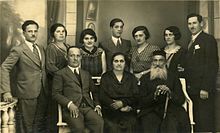 A Jewish family in Galați, Romania during the Interwar period | |
| Total population | |
|---|---|
| est. 280,000 to 460,000 (worldwide) | |
| Regions with significant populations | |
| 3,271 (2011 census) 9,700 (core population, 2002 est.)[1] 8,000 (2018 estimated population)[2] | |
| 276,588 (emigrants to Israel 1948–2010)[3] 450,000 (2005 estimated population)[4] | |
| Languages | |
| Romanian, Hebrew, Yiddish, German, Russian, Hungarian, Polish and English | |
| Religion | |
| Judaism | |
| Related ethnic groups | |
| Jews, Ashkenazi Jews, Sephardic Jews, Moldovan Jews, Bessarabian Jews, Ukrainian Jews, Polish Jews, Hungarian Jews, Turkish Jews, Belarusian Jews, Lithuanian Jews, Bulgarian Jews | |
| Part of a series on |
| Jews and Judaism |
|---|
The history of the Jews in Romania concerns the Jews both of Romania and of Romanian origins, from their first mention on what is present-day Romanian territory. Minimal until the 18th century, the size of the Jewish population increased after around 1850, and more especially after the establishment of Greater Romania in the aftermath of World War I. A diverse community, albeit an overwhelmingly urban one, Jews were a target of religious persecution and racism in Romanian society from the late-19th century debate over the "Jewish Question" and the Jewish residents' right to citizenship, to the genocide carried out in the lands of Romania as part of the Holocaust. The latter, coupled with successive waves of aliyah, has accounted for a dramatic decrease in the overall size of Romania's present-day Jewish community.
During the reign of Peter the Lame (1574–1579), the Jews of Moldavia, mainly traders from Poland who were competing with locals, were taxed and ultimately expelled.[5] The authorities decided in 1650 and 1741 that Jews had to wear clothing evidencing their status and ethnicity.[6] The first blood libel in Moldavia (and, as such, in Romania) was made in 1710, when the Jews of Târgu Neamț were charged with having killed a Christian child for ritual purposes.[7] An anti-Jewish riot occurred in Bucharest in the 1760s.[8] During the Russo-Turkish War, 1768–1774, the Jews in the Danubian Principalities had to endure great hardships. Massacres and pillages were perpetrated in almost every town and village in the country. During the Greek War of Independence, which signalled the Wallachian uprising of 1821, Jews were victims of pogroms and persecutions. In the 1860s, there was another riot motivated by blood libel accusations.[9]
Antisemitism was officially enforced under the premierships of Ion Brătianu. During his first years in office (1875) Brătianu reinforced and applied old discrimination laws, insisting that Jews were not allowed to settle in the countryside (and relocating those that had done so), while declaring many Jewish urban inhabitants to be vagrants and expelling them from the country. The emigration[dubious – discuss] of Romanian Jews on a larger scale commenced soon after 1878. By 1900 there were 250,000 Romanian Jews: 3.3% of the population, 14.6% of the city dwellers, 32% of the Moldavian urban population and 42% of Iași.[10]
Between the establishment of the National Legionary State (September 1940) and 1942, 80 anti-Jewish regulations were passed. Starting at the end of October, 1940, the Romanian fascist movement known as the Iron Guard began a massive antisemitic campaign, torturing and beating Jews and looting their shops (see Dorohoi pogrom), culminating in the failed coup accompanied by a pogrom in Bucharest, in which 125 Jews were killed.[11] Military dictator Ion Antonescu eventually stopped the violence and chaos created by the Iron Guard by brutally suppressing the rebellion, but continued the policy of oppression and massacre of Jews, and, to a lesser extent, of Roma. After Romania entered the war at the start of Operation Barbarossa, atrocities against Jews became common, starting with the Iași pogrom. According to the Wiesel Commission report released by the Romanian government in 2004, between 280,000 and 380,000 Jews were murdered in the Holocaust in Romania and the occupied Soviet territories under Romanian control, among them the Transnistria Governorate. An additional 135,000 Jews living under Hungarian control in Northern Transylvania also were murdered in the Holocaust, as were some 5,000 Romanian Jews in other countries.[12][13][14]
On the current territory of Romania, between 290,000 and 360,000 Romanian Jews survived World War II (355,972 persons, according to statistics from the end of the war).[15] During the communist regime in Romania, there was a mass emigration to Israel, and in 1987, only 23,000 Jews lived in Romania.
Today, the majority of Romanian Jews live in Israel, while modern-day Romania continues to host a modest Jewish population. In the 2011 census, 3,271 people declared themselves to be Jewish.
- ^ "Archived copy" (PDF). Archived from the original (PDF) on 2012-02-09. Retrieved 2019-01-28.
{{cite web}}: CS1 maint: archived copy as title (link) - ^ "Comunitatea evreilor din România s-a împuţinat teribil, însă aceştia 'sunt mai ales exemple de moralitate'". Archived from the original on 2019-01-29. Retrieved 2019-01-28.
- ^ "Archived copy" (PDF). Archived from the original (PDF) on 2014-08-12. Retrieved 2019-01-28.
{{cite web}}: CS1 maint: archived copy as title (link) - ^ "PM Sharon Meets Romanian PM". Prime Minister's Office.
- ^ Rezachevici, September 1995, p. 61
- ^ Oișteanu (1998), p. 239
- ^ Oișteanu (2003), p. 2; Rezachevici, October 1995, p. 66
- ^ Cernovodeanu, p. 27
- ^ Oișteanu (2003), p. 2
- ^ A History of the Balkans 1804–1945, p. 129
- ^ Veiga, p. 301
- ^ Ilie Fugaru, Romania clears doubts about Holocaust past, UPI, November 11, 2004
- ^ International Commission on the Holocaust in Romania (2012-01-28). "Executive Summary: Historical Findings and Recommendations" (PDF). Final Report of the International Commission on the Holocaust in Romania. Yad Vashem (The Holocaust Martyrs' and Heroes' Remembrance Authority). Retrieved 2012-01-28.
- ^ Cite error: The named reference
Yad Vashemwas invoked but never defined (see the help page). - ^ Alexandru Florin-Platon. "O necesară restituţie biografică (Carol Iancu, Alexandru Şafran: o viaţă de luptă, o rază de lumină)". Revista Contrafort. Retrieved 2019-01-28.